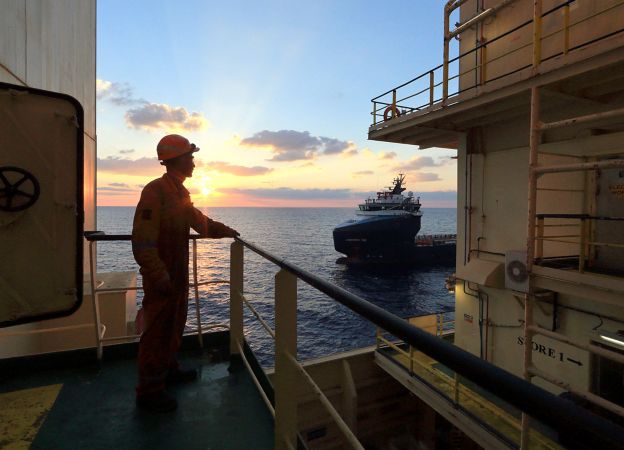1,768 bcf
annual natural gas production in 2024 (billion cubic feet)

Or , our new artificial intelligence tool.
We use the best exploration technologies to locate the most promising resources and bring them rapidly into production.
We are continually investing to stay at the forefront of subsurface data acquisition, management and interpretation. Only by improving our knowledge in geology and geophysics, integrating them and developing models derived from these disciplines can we deepen and accelerate our understanding of the subsurface, thus optimising the operational and economic risks associated with our activities and reducing our impact on the environment.
The continual updating of theoretical knowledge in the geosciences, coupled with the ever-increasing use of digital technologies, will significantly improve the efficiency and safety of work flows applied to subsurface analysis, not only applied to traditional exploration, such as the identification of new gas fields, but also to activities supporting the energy transition, such as the identification and management of CO2 storage sites, as well as the exploration of geothermal sites, hydrogen deposits and critical minerals.
Fundamental to this are the experimental geosciences, a set of disciplines in geology aimed at rebuilding the structure of underground rocks where hydrocarbon reserves may be present. Their valuable contribution is constantly complemented by digital geosciences, which are supported by our supercomputer. These disciplines are also applied in carbon capture and storage.
Thanks to the skills and technologies of our Research Centres, we are able to identify new natural gas deposits more precisely and efficiently.
A technological lever to accelerate Eni’s transformation and support the development of high-potential new businesses.

The computing power of supercomputers, combined with the expertise of geologists and engineers, is the secret to our successes in geophysical exploration.

Our laboratories are equipped with increasingly advanced instrumentation for the analysis of rock samples from the subsurface.

Using HPC6, our researchers can understand the subsurface in an increasingly precise and safe way.
The study of the subsoil is based on basic theoretical knowledge that applies to both traditional and energy transition objectives. Discovering the age of underground rock formations, studying their composition, porosity and permeability, as well as reconstructing the geometry, extent and volume of sedimentary bodies and the palaeoenvironmental conditions in which they were formed, are fundamental when it comes to understanding the nature and characteristics of reservoirs to extract natural gas from or to be used for the storage of CO2.
Besides using up-to-date theoretical skills and modern, purpose-built integrated workflows, our technicians have access to the use of technology and sophisticated analysis tools that enable them to study the data extracted from the subsoil in depth and optimise results.
Last but not least, studying surface geology, by surveying campaigns of outcropping rocks or through the use of digital acquisitions of the earth's surface, allow us to obtain essential data to support geological modelling activities, as well as monitoring the sites where we operate (environmental studies). Owning advanced proprietary technologies that enable large amounts of high quality data to be acquired and processed is therefore crucial to increasing our ability to predict the variability of subsoil rocks.
Progress in technology and digital technologies, in particular, have made it possible to significantly increase the performance of experimental activities, such as laboratory analyses. Modern machine learning and artificial intelligence methodologies also offer the possibility of optimising how proprietary databases are managed and integrated with the data available in public databases or traceable to specialised literature. The increase in the robustness of three-dimensional quantitative geological models also depends on the need to calibrate them to a large number of data that will be analysed and integrated in an ever shorter timeframe, in the face of an ever-increasing availability of information.
Latest results and growth targets in natural gas.
annual natural gas production in 2024 (billion cubic feet)
gas share in total O&G production by 2030
gas share in total O&G production by 2050
A journey to discover geology.
In the playlist 'Rock hunters', geologist Emiliano Mutti, recipient of the Eni Award in 2016, guides us through the study of the geological features of the Pyrenees and Apennines. A journey of significant academic, industrial, and aesthetic importance.
Watch the playlistA journey to discover geology.
25 October 2016
Our supercomputer allows us to expand geophysical exploration to quickly identify new natural gas fields.
The profound knowledge of the subsoil which, thanks to the geosciences we have gained through our Oil & Gas activities, proves invaluable in the field of capture, storage and utilisation of CO2 (CCUS). Studying and understanding the characteristics of underground rocks and the behaviour of fluids moving within them, in particular through the experimental geosciences, allows us to accurately assess the capacity to store carbon dioxide from depleted gas reservoirs. In this way, we can identify those that are best suited to host carbon capture and storage (CCS) facilities and, subsequently, we are able to manage their operation safely and efficiently.
Our projects for carbon capture, utilization and storage (CCUS), a set of technologies essential for reducing emissions.

If you want to change topic, clear the chat and make a new query to receive more relevant results.
This will delete the question history.
If you want to change topic, clear the chat and make a new query to receive more relevant results. This will delete the question history.
Here you can find the full list of your queries.
The answers are generated by artificial intelligence, therefore they may contain inaccuracies. Please read the terms and conditions of use.

EnergIA is an innovative tool based on artificial intelligence capabilities, which can help you navigate the contents of eni.com, quickly finding answers to your questions. EnergIA can also perform a search on a specific topic, providing the most up-to-date data available, or it can invite you to delve deeper into a topic of your interest by suggesting links and specific readings. Start now!
EnergIA is an innovative tool based on artificial intelligence capabilities, which can help you navigate the contents of eni.com, quickly finding answers to your questions. Start now!
EnergIA (ener'dʒia) is a system based on Generative Artificial Intelligence.
Thanks to this technology, we can respond to your requests by querying the most relevant content and documents available on eni.com. (Note: financial documents from the last 12 months and press releases from the last 2 years are considered.)
Through EnergIA, you can delve into topics of interest and have a real-time window into the world of Eni.
If you wish to search for a specific document, press release or news, use the traditional search engine via the magnifying glass icon.
Like all systems that leverage Generative Artificial Intelligence, EnergIA may generate inaccurate or outdated responses. Always consult the sources that EnergIA proposes as the origin of the generated information.
If the system fails to find an exact match for the requested content, it still tends to provide a response.
If you find any inaccuracies in the provided response, please send us your feedback at the bottom of the page: it will be very helpful for us to improve.
Remember that the content generated by the system does not represent Eni’s official position. We therefore invite stakeholders to refer to their designated contacts for official statements: Press Office for journalists, Investor Relations for analysts and investors, Company Secretariat for shareholders etc..
EnergIA can understand questions posed in almost all languages, but we prefer to provide you with a response in English or Italian, the two languages available on eni.com. If you ask a question in Italian, the content on the site in Italian will be consulted. If you ask it in English or any other language, the content in English will be consulted. (Note: the language Eni uses for financial documents/content is predominantly English.)
If questions are formulated that violate the set security criteria, the system will not proceed with processing the response. Please remember not to send personal data.
By using this service, the users acknowledge that they have read and accepted the terms and conditions of use.
Search
EnergIA (ener'dʒia) is a system based on Generative Artificial Intelligence.
Thanks to this technology, we can respond to your requests by querying the most relevant content and documents available on eni.com. (Note: financial documents from the last 12 months and press releases from the last 2 years are considered.)
Through EnergIA, you can delve into topics of interest and have a real-time window into the world of Eni.
If you wish to search for a specific document, press release or news, use the traditional search engine via the magnifying glass icon.
Like all systems that leverage Generative Artificial Intelligence, EnergIA may generate inaccurate or outdated responses. Always consult the sources that EnergIA proposes as the origin of the generated information.
If the system fails to find an exact match for the requested content, it still tends to provide a response.
If you find any inaccuracies in the provided response, please send us your feedback at the bottom of the page: it will be very helpful for us to improve.
Remember that the content generated by the system does not represent Eni’s official position. We therefore invite stakeholders to refer to their designated contacts for official statements: Press Office for journalists, Investor Relations for analysts and investors, Company Secretariat for shareholders etc..
EnergIA can understand questions posed in almost all languages, but we prefer to provide you with a response in English or Italian, the two languages available on eni.com. If you ask a question in Italian, the content on the site in Italian will be consulted. If you ask it in English or any other language, the content in English will be consulted. (Note: the language Eni uses for financial documents/content is predominantly English.)
If questions are formulated that violate the set security criteria, the system will not proceed with processing the response. Please remember not to send personal data.
By using this service, the users acknowledge that they have read and accepted the terms and conditions of use.
A new window into Eni’s world, at your disposal. EnergIA is an innovative tool based on artificial intelligence capabilities, which can help you navigate the contents of eni.com, quickly finding answers to your questions.

